Weekly Reports from Jordan
Choose Year: or Choose week
The Road to L
Larry G. Herr and Douglas R. Clark
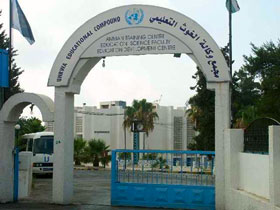 Lest readers of these reports think that all we do is work in the field and gather layers of dust on our faces, an archaeological dig includes work that goes on in camp, too, especially regarding objects and pottery. So far, we have discovered about 450 objects/artifacts. Almost half of them have been found in Field L (hence the title of this report), located along the southern lip of the site. Although that team is relatively small, they have produced a wealth of small finds. And almost all of them are broken pieces of grinding stones, spindle whorls made from old broken pottery sherds, jar stoppers also made from reused sherds, and potter's marks. Once in a while they have found better things, like two seals, or a figurine head, or Hellenistic coins, or a complete needle. The rest of us find objects from time to time, also.
Lest readers of these reports think that all we do is work in the field and gather layers of dust on our faces, an archaeological dig includes work that goes on in camp, too, especially regarding objects and pottery. So far, we have discovered about 450 objects/artifacts. Almost half of them have been found in Field L (hence the title of this report), located along the southern lip of the site. Although that team is relatively small, they have produced a wealth of small finds. And almost all of them are broken pieces of grinding stones, spindle whorls made from old broken pottery sherds, jar stoppers also made from reused sherds, and potter's marks. Once in a while they have found better things, like two seals, or a figurine head, or Hellenistic coins, or a complete needle. The rest of us find objects from time to time, also.
When we find an object or artifact in the field it is covered with dirt, many times disguising what it is. Diggers usually recognize that it is something other than a simple clod of dirt or a pebble and place it in a plastic bag (or paper for metal and bone to avoid excessive "sweating") with a tag containing the data where it was found. They bring it back to camp and place it in one of four crates (flints, bones, stone objects, light objects).
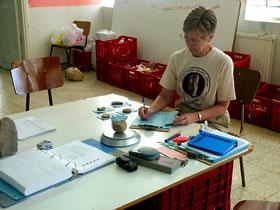 This is where the work of Carmen Clark, Object Registrar, begins. She collects the bags, washes the individual artifacts, dries them by leaving them on a table for a few hours, and lays them on the "object reading" table. After pottery reading every day a team of specialists gathers around the table and decides what each object is and begins the description process. The team includes co-directors Doug Clark and Larry Herr, Carmen Clark (registrar), Julie Cormack (flints and lithics), Mary Boyd (textiles), Rhonda Root (artist), Kent Bramlett (field supervisor), and Bob Bates (field supervisor).
This is where the work of Carmen Clark, Object Registrar, begins. She collects the bags, washes the individual artifacts, dries them by leaving them on a table for a few hours, and lays them on the "object reading" table. After pottery reading every day a team of specialists gathers around the table and decides what each object is and begins the description process. The team includes co-directors Doug Clark and Larry Herr, Carmen Clark (registrar), Julie Cormack (flints and lithics), Mary Boyd (textiles), Rhonda Root (artist), Kent Bramlett (field supervisor), and Bob Bates (field supervisor).
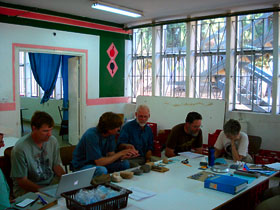 While some of us would like to discover written instructions or users' manuals along with objects, almost none of them come with a clear designation of how the ancient people used them. But there is a long history of scholarly convention and we hope that, by using a team like this, most objects will receive a designation that reasonably approximates their use in antiquity. However, there are many times when we simply must confess that we don't know what the objects were.
While some of us would like to discover written instructions or users' manuals along with objects, almost none of them come with a clear designation of how the ancient people used them. But there is a long history of scholarly convention and we hope that, by using a team like this, most objects will receive a designation that reasonably approximates their use in antiquity. However, there are many times when we simply must confess that we don't know what the objects were.
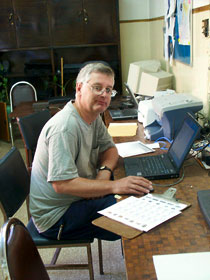 The team also agrees on certain categories for the computer database, such as shape, material, percentage of preservation (we receive mostly fragments), degree of craftsmanship, and any other modifiers which help to explain the object. The team also separates between objects with museum importance and artifacts suitable only for scholarly study. The former go to us on short-term loan for study (one year, renewable). We receive the latter on a long-term loan basis. Everything belongs to the people of Jordan, but non-museum items are often better studied over a long period of time at one of our consortium schools.
The team also agrees on certain categories for the computer database, such as shape, material, percentage of preservation (we receive mostly fragments), degree of craftsmanship, and any other modifiers which help to explain the object. The team also separates between objects with museum importance and artifacts suitable only for scholarly study. The former go to us on short-term loan for study (one year, renewable). We receive the latter on a long-term loan basis. Everything belongs to the people of Jordan, but non-museum items are often better studied over a long period of time at one of our consortium schools.
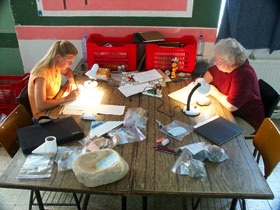 Carmen then places the objects on another table for the photographer and artists. Rhonda Root and Stefanie Elkins have drawn almost half of the objects so far. Naturally, they leave the least interesting for later work. Myron Widmer and Monique Acosta have photographed everything meticulously with scale sticks. These photos and drawings will accompany the catalogue of objects we publish with each seasonal report.
Carmen then places the objects on another table for the photographer and artists. Rhonda Root and Stefanie Elkins have drawn almost half of the objects so far. Naturally, they leave the least interesting for later work. Myron Widmer and Monique Acosta have photographed everything meticulously with scale sticks. These photos and drawings will accompany the catalogue of objects we publish with each seasonal report.
When the processing is complete, Carmen packs every piece in plastic bags with identification tags and then stores them in crates for shipment to Walla Walla 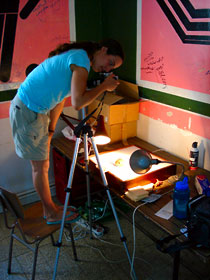 College where the objects from previous seasons are presently stored and where student assistant Monique Acosta, with help from Boris Brajnikoff and Lindsey Hill, will sort the objects by types. Back in camp, Carmen enters the data into a computer database which is printed out at the end of the season in 10 copies. These include the designations, registry numbers, and provenance data along with a color photo. One copy becomes the master registry that is presented to the Department of Antiquities of Jordan as the official registry of objects for that season. All short-term and long-term loans are based on this document.
College where the objects from previous seasons are presently stored and where student assistant Monique Acosta, with help from Boris Brajnikoff and Lindsey Hill, will sort the objects by types. Back in camp, Carmen enters the data into a computer database which is printed out at the end of the season in 10 copies. These include the designations, registry numbers, and provenance data along with a color photo. One copy becomes the master registry that is presented to the Department of Antiquities of Jordan as the official registry of objects for that season. All short-term and long-term loans are based on this document.
The Department of Antiquities must accept this document before anything can clear customs to be shipped to North America. We usually have an agent take care of customs and shipping. It seems like a long process, but every step of the way is necessary. Doug Clark, along with Karen Borstad, also involved in the handling of objects and their record-keeping, will use all the information to complete the published catalogue of our objects.
And then there's the pottery. We find 2000-3000 pieces of broken pottery every day. Processing the pottery isn't as complex as the objects, but it consumes the afternoons of most of our people. At four o'clock, after our siesta time, we retrieve the pails of pottery diggers brought back from the field earlier that day. Denise Herr, pottery registrar, has filled the pails with water to soak into the dirt covering the sherds. We use stiff brushes with the water to wash the sherds. As we wash we place the sherds with rims or bases, or other diagnostic markers in a mesh bag and all other sherds, together with the mesh bag, in a plastic basket and transfer the pottery tag from the pail to the basket. We then place the basket in the sun to dry the pottery until the next day.
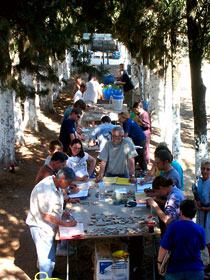 The next day at four o'clock is "pottery reading." Supervisors and assistants place the dry pottery from the baskets onto five large tables, pail after pail, until all are filled up. Then they go back to washing the pottery they found that day. Meanwhile, Larry Herr examines the pottery sherds pail by pail and gives a "call" for each one.
The next day at four o'clock is "pottery reading." Supervisors and assistants place the dry pottery from the baskets onto five large tables, pail after pail, until all are filled up. Then they go back to washing the pottery they found that day. Meanwhile, Larry Herr examines the pottery sherds pail by pail and gives a "call" for each one.
The "call" includes chronological groupings, such as "late Iron 2/Persian" or "Late Bronze," while also giving vessel designations for each group, such as jar, jug, bowl, lamp, etc.
This is one of the most important parts of the day. It is where the rubber meets the road. We discover the date of the dirt we are digging and whatever architecture was associated with this dirt. Each field team breaks from 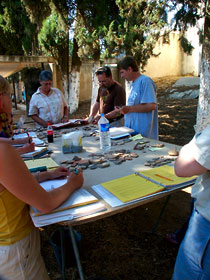 their pottery washing to attend the pottery reading. The field supervisors and square supervisors carefully record the data in notebooks, while an assistant records it on the identification tag that was with the pail in the field. Denise also records the data in a master registry list and gathers all tags with the diagnostic pottery (rims, bases, handles, painted wares, etc) for storage.
their pottery washing to attend the pottery reading. The field supervisors and square supervisors carefully record the data in notebooks, while an assistant records it on the identification tag that was with the pail in the field. Denise also records the data in a master registry list and gathers all tags with the diagnostic pottery (rims, bases, handles, painted wares, etc) for storage.
Sometimes, certain sherds are designated for "publication." This means they will receive further immediate study and possible inclusion in the published drawings of pottery that appear in each of our major book-length seasonal reports. Denise places them in special plastic bags with a special pink tag.
Once the reading of each pail is finished and the diagnostic and publishable pottery is separated, the remainder of the body sherds are scraped off the table into pails, transported back to the tell next day, and discarded on the large mountain of pottery at the base of the tell—the pottery dump, or Jebel Fukhar – the Mountain of Pottery. Future archaeologists could use these sherds for further work.
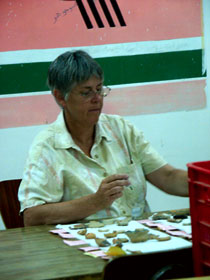 The diagnostic pottery (about one-eighth to one-tenth of the total) is stored in crates by square and shipped back to La Sierra University for permanent storage. Other scholars may examine and work with this pottery by contacting us. The publishable pottery is registered by Denise, given diameters by Larry (he uses a "diameter chart" of concentric circles and compares each sherd to it), and shipped to Canadian University College where it is prepared for publication by student assistant Bethany Reiswig in another lengthy process of drawing and analysis.
The diagnostic pottery (about one-eighth to one-tenth of the total) is stored in crates by square and shipped back to La Sierra University for permanent storage. Other scholars may examine and work with this pottery by contacting us. The publishable pottery is registered by Denise, given diameters by Larry (he uses a "diameter chart" of concentric circles and compares each sherd to it), and shipped to Canadian University College where it is prepared for publication by student assistant Bethany Reiswig in another lengthy process of drawing and analysis.
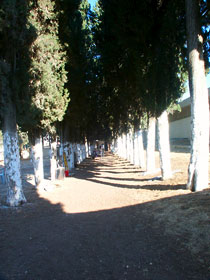 Other activities take place at ATC and the following series of photos will hopefully paint a picture of our home away from home:
Other activities take place at ATC and the following series of photos will hopefully paint a picture of our home away from home:
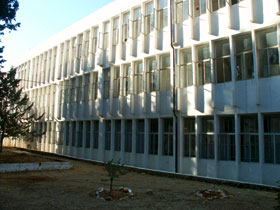 |
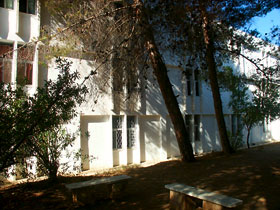 |
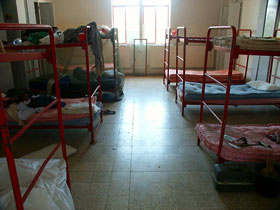 |
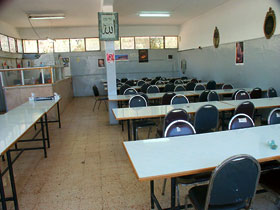 |
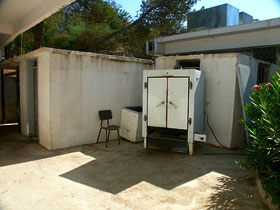 |
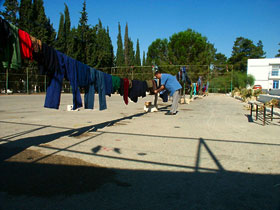 |
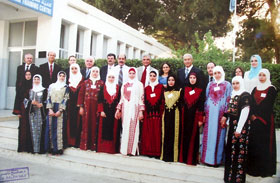 |
The work on the tell is nearly finished and there is much to report, but, with only one or two more days of actual digging, we will hold off until next week's report. We will also combine it with a final account of our field finds.
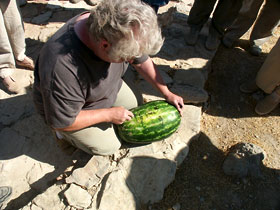 But we should mention an event held on Monday, the third seasonal mill stone toss, performed only by the women of the team from atop the four-room house in honor of the nameless woman of Thebez, mentioned in the biblical story of Abimelech in the book of Judges.
But we should mention an event held on Monday, the third seasonal mill stone toss, performed only by the women of the team from atop the four-room house in honor of the nameless woman of Thebez, mentioned in the biblical story of Abimelech in the book of Judges.
According to the story, it was a woman with domestic implements in hand who tossed an upper milling stone (about the size of a loaf of bread, but much heavier than most loaves of bread) onto the head of Abimelech who wanted to be king in Israel. Having been clunked hard by the mill stone, Abimelech cried out for his 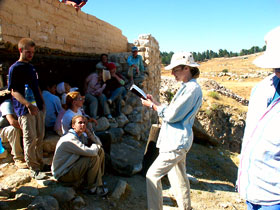 armor bearer to thrust him through lest it be recorded that he died at the hands of a woman—which is why we remember the event so well. Some have argued that a woman could not have done this, so the women of `Umayri attempt each season of excavation to prove not only that it can be done, but that it can be done well. Watermelon Abimelech survived the first round of around 25 stones, but succumbed fatally to a blow from Erica Hufnagel whose second stone smashed Abimelech to smithereens.
armor bearer to thrust him through lest it be recorded that he died at the hands of a woman—which is why we remember the event so well. Some have argued that a woman could not have done this, so the women of `Umayri attempt each season of excavation to prove not only that it can be done, but that it can be done well. Watermelon Abimelech survived the first round of around 25 stones, but succumbed fatally to a blow from Erica Hufnagel whose second stone smashed Abimelech to smithereens.
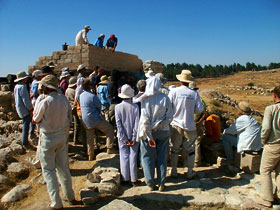 |
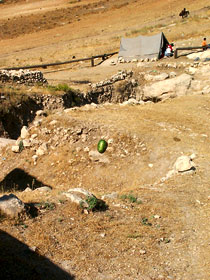 |
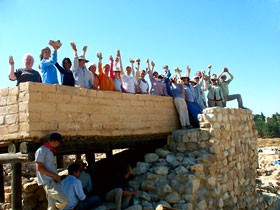 |
|
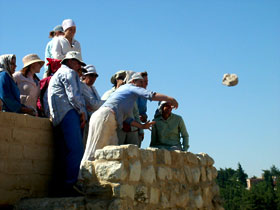 |
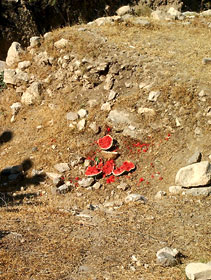 |
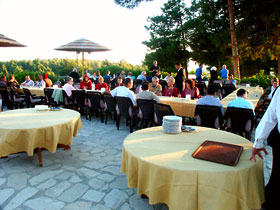 We should also mention the mensef. This is the traditional feast of the Bedouin and is a cultural experience no visitor to Jordan should miss. Everyone got on the buses last Saturday night for the brief trip to Seven Hills Restaurant, beautifully situated just south of our tell in the forested hills overlooking the Madaba Plain. We watched waiters bring large platters covered with a mound of rice with pine nuts and slivered almonds topped by boiled lamb and a yogurt sauce. Muhammad the cook showed us how we were to eat the food with our right hands, dipping our fingers into the rice and meat,
We should also mention the mensef. This is the traditional feast of the Bedouin and is a cultural experience no visitor to Jordan should miss. Everyone got on the buses last Saturday night for the brief trip to Seven Hills Restaurant, beautifully situated just south of our tell in the forested hills overlooking the Madaba Plain. We watched waiters bring large platters covered with a mound of rice with pine nuts and slivered almonds topped by boiled lamb and a yogurt sauce. Muhammad the cook showed us how we were to eat the food with our right hands, dipping our fingers into the rice and meat, 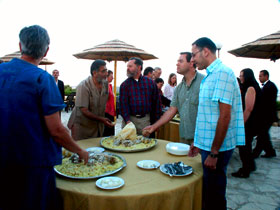 forming balls of it with our hands, and then popping it into our mouths without touching our fingers to our mouth. There was much amusement as we got used to the process, but the food was very good and we soon became old pros. There was also a similar arrangement for vegetarians that included cauliflower and eggplant instead of the lamb. The time also served to honor various people and groups who have helped us during the season.
forming balls of it with our hands, and then popping it into our mouths without touching our fingers to our mouth. There was much amusement as we got used to the process, but the food was very good and we soon became old pros. There was also a similar arrangement for vegetarians that included cauliflower and eggplant instead of the lamb. The time also served to honor various people and groups who have helped us during the season.
The weather. Most of us have been reading about the terrible heat wave in North America. Even the Canadians among us sympathize (slightly!) with our sweltering 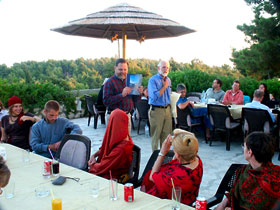 families in Alberta. Most people think the Middle East is hot and dry. And that's true for a large part of it. However, as we write this report, it is 8 AM and the temperature is in the mid 60s F (21-22 C) with a cool breeze from the west. We moved away from the windows at breakfast. Normal midday temperatures are in the mid to upper 80s (27-29 C) with a strong cooling dry breeze. Hot days are in the low to mid 90s (34-35 C), but there is almost always a breeze that, because it so dry, cools us by evaporating our sweat almost before we sweat. So we are staying blissfully cool (relatively!).
families in Alberta. Most people think the Middle East is hot and dry. And that's true for a large part of it. However, as we write this report, it is 8 AM and the temperature is in the mid 60s F (21-22 C) with a cool breeze from the west. We moved away from the windows at breakfast. Normal midday temperatures are in the mid to upper 80s (27-29 C) with a strong cooling dry breeze. Hot days are in the low to mid 90s (34-35 C), but there is almost always a breeze that, because it so dry, cools us by evaporating our sweat almost before we sweat. So we are staying blissfully cool (relatively!).
Although the word play in our title suggests we are sweltering in heat, it actually is intended to reflect, along with all the objects we have found in Field L, the road we have avoided by coming to cool Jordan this summer. No need for air conditioning here.
"Which way does one face in this thing?" — Teacher, Jeanne DelColle orienting herself to the Turkish toilet.
"Just make it up!" — Denise Herr, the mother of notebooks, responsible for the absolute accuracy of all notebook entries, shouted across Field A to Tom Venner who needed to know how to estimate the number of stones per guffa in a particular locus.
"You have to wear your underwear on the outside of your pants to see if anyone notices." — End-of-season sentiments of David Hopkins, veteran of several archaeological campaigns.
"If there's no vomit, there's no excuse for missing classes." — Jeanne DelColle, our New Jersey teacher about high school students who either don't show up for school or don't do much while there.
"I'm always cold." — Bethany Reiswig, from Aleknagik, Alaska, who should know about cold.
[In case you have not discovered it yet, you can click on any photo and set up a slide show for each of the weekly reports.]